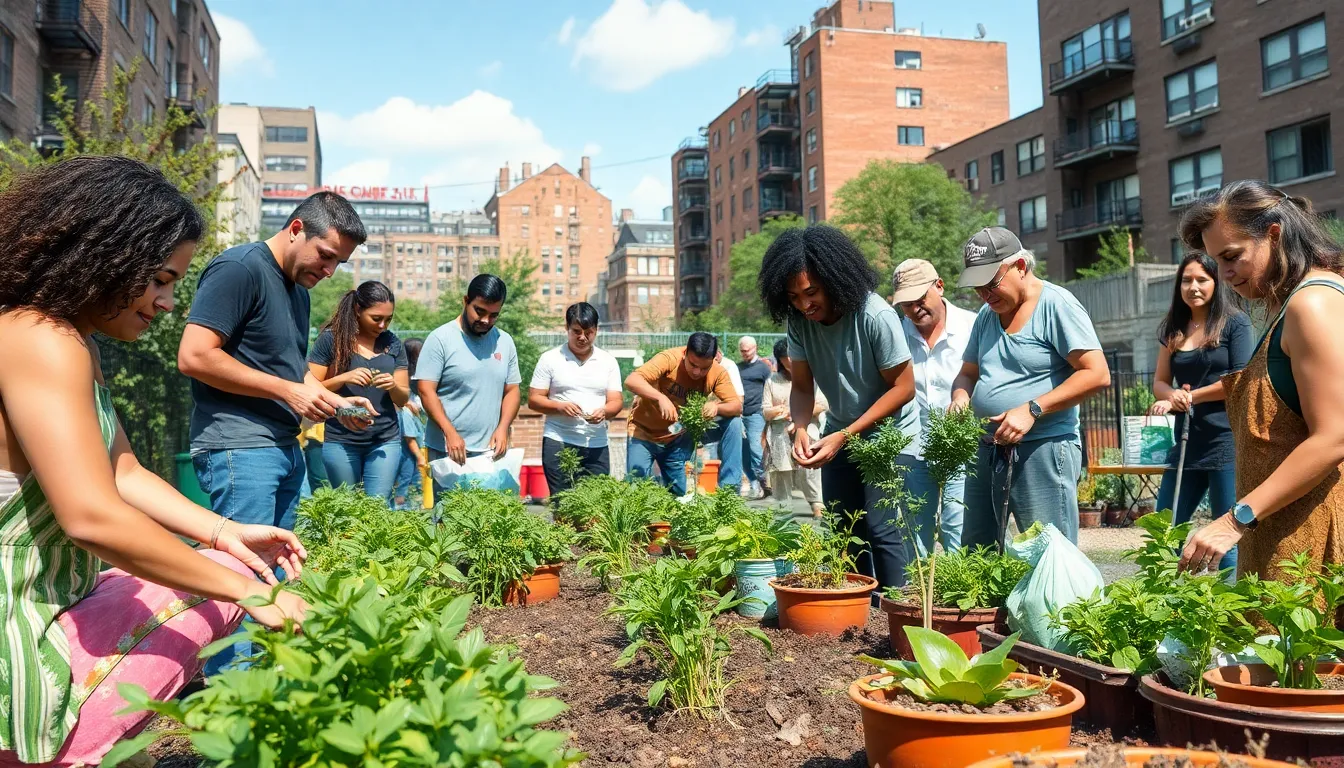Sustainable living isn’t just a trendy buzzword; it’s a lifestyle choice that can save the planet and your sanity. Imagine a world where your morning coffee doesn’t come with a side of guilt and your grocery shopping doesn’t feel like a game of environmental roulette. It’s all about making choices that keep Mother Earth happy while still enjoying life’s little pleasures.
But what does sustainable living really mean? It’s not about wearing hemp sandals and chanting with tree-huggers (unless that’s your thing). It’s about understanding how to meet our needs without compromising the ability of future generations to meet theirs. So buckle up, because diving into the world of sustainable living is not only enlightening; it’s downright essential for a brighter, greener future.
Table of Contents
ToggleUnderstanding Sustainable Living Definition
Sustainable living involves lifestyle choices that emphasize environmental preservation and personal health. This concept prioritizes meeting today’s needs without compromising the ability of future generations to meet theirs. It encompasses various practices, such as reducing waste, conserving energy, and choosing sustainable products.
Making conscious decisions forms the core of sustainable living. For example, individuals may opt for reusable bags during grocery shopping instead of single-use plastic. Composting organic waste contributes to reducing landfill accumulation while enriching soil quality.
Sustainable living extends to transportation choices as well. Using public transport, biking, or walking decreases carbon footprints and promotes healthier lifestyles. Mindful consumption further reinforces this approach, encouraging people to favor local and organic products over mass-produced items.
Education plays a vital role in understanding sustainable living. Awareness of environmental issues like climate change or resource depletion fosters informed decision-making. Community involvement amplifies these efforts, as groups often collaborate on initiatives to promote sustainability.
Adopting a sustainable lifestyle influences not just the planet, but also individual well-being. Stress reduction and improved quality of life can result from connecting with nature and engaging in eco-friendly practices. Overall, this definition centers on creating a balance that ensures both present and future generations thrive in a healthy environment.
Key Principles of Sustainable Living

Sustainable living revolves around key principles that guide individuals toward eco-friendly choices. Each principle plays a significant role in fostering a healthier planet.
Environmental Stewardship
Environmental stewardship focuses on protecting natural resources. Individuals can conserve water by fixing leaks and reducing runoff. Supporting biodiversity through native gardening prevents habitat destruction. Utilizing renewable energy sources like solar or wind minimizes carbon footprints. Recycling materials such as paper and plastic not only reduces waste but also saves energy. Making environmentally conscious decisions leads to a sustainable ecosystem.
Social Responsibility
Social responsibility emphasizes the impact of lifestyle choices on communities. Choosing fair trade products supports economic stability in developing nations. Additionally, engaging in local initiatives promotes community well-being. Advocating for social equity ensures that everyone has access to resources. Aiming for inclusivity encourages diverse perspectives in sustainability efforts. Participating in community events fosters connections while inspiring collective action.
Economic Viability
Economic viability considers the financial aspects of sustainable living. Investing in energy-efficient appliances yields long-term savings on utility bills. Supporting local businesses strengthens local economies while reducing transportation emissions. Emphasizing sustainable agriculture promotes healthy food systems and creates jobs. Practicing mindful consumption encourages smart spending. Prioritizing sustainability leads to economic stability and growth for future generations.
Benefits of Sustainable Living
Sustainable living offers numerous advantages that positively impact both individuals and the environment. Embracing this lifestyle fosters a healthier community while promoting economic efficiency.
Health and Well-being
Improved health results from adopting sustainable practices. Consuming organic foods contributes to greater nutrition and reduced exposure to harmful chemicals. Fresh, local produce often contains more vital nutrients than processed alternatives. Reducing waste through composting not only decreases landfill impact but also enriches soil for gardening. Engaging in outdoor activities, like biking and hiking, enhances physical fitness while strengthening connections to nature. Surrounding oneself with green spaces promotes mental well-being, creating a sense of peace and tranquility.
Financial Savings
Financial savings come from integrating sustainable choices into daily life. Energy-efficient appliances significantly lower utility bills over time, providing a worthwhile investment. Shopping locally supports community businesses and reduces transportation costs. Utilizing public transport or carpooling minimizes fuel expenses, yielding more savings. Such shifts in habits also lead to reduced trash disposal fees as waste decreases. Ultimately, choosing sustainable options creates both immediate and long-term financial benefits.
Challenges to Sustainable Living
Sustainable living faces several challenges that can impede its widespread adoption.
Accessibility Issues
Access to sustainable options remains a significant barrier. Many individuals live in food deserts where organic or local products aren’t available. Public transport infrastructure often lacks efficiency in less populated areas, making car dependency the norm. Additionally, energy-efficient appliances can be financially unattainable for lower-income households. Without affordable and convenient alternatives, committing to a sustainable lifestyle becomes difficult for many.
Misconceptions About Sustainability
Misunderstandings about what sustainability entails also pose challenges. Some people associate sustainable living solely with expensive, niche products. Others view it as a lifestyle that requires drastic changes or sacrifices. These misconceptions can discourage individuals from making small changes that align with sustainable principles. Education plays a key role in reshaping these views, clarifying that even modest adjustments can significantly impact both personal well-being and the environment.
Sustainable living is a powerful choice that intertwines personal health with environmental responsibility. By embracing simple practices like reducing waste and choosing eco-friendly products, individuals can make a meaningful impact. This lifestyle fosters a deeper connection with nature while promoting community engagement and social responsibility.
Despite challenges such as accessibility and misconceptions, the journey toward sustainability is attainable through education and small, conscious changes. Each step taken not only benefits the planet but also enhances overall well-being. As people continue to prioritize sustainability, they pave the way for a healthier environment and a brighter future for generations to come.






